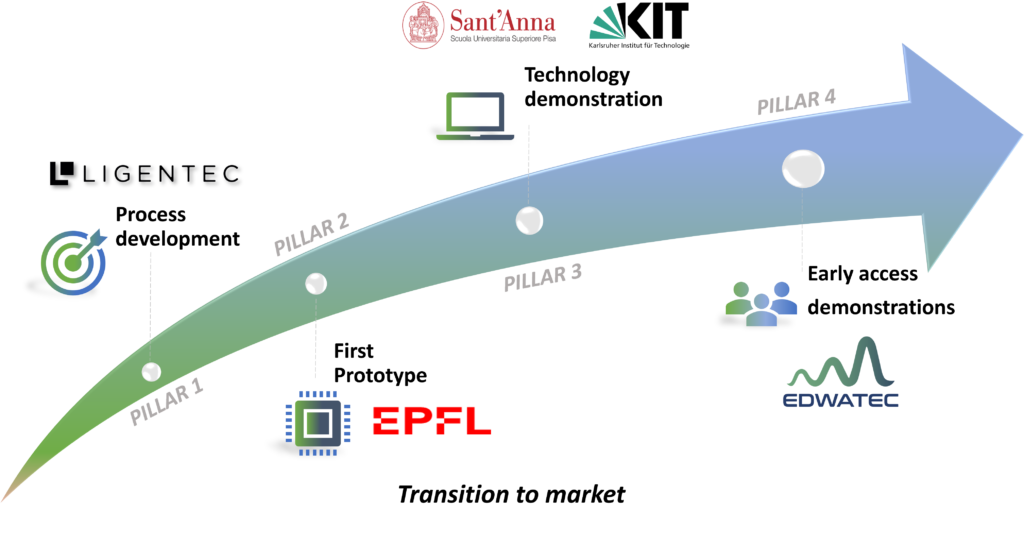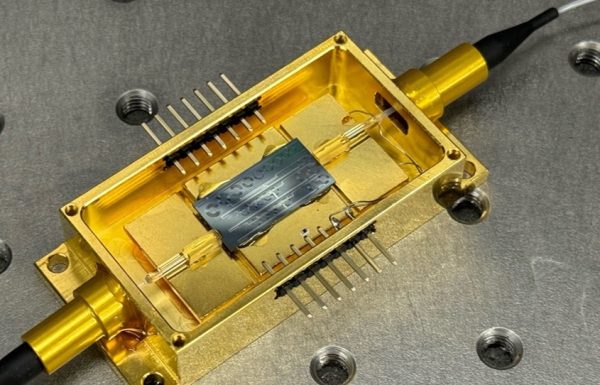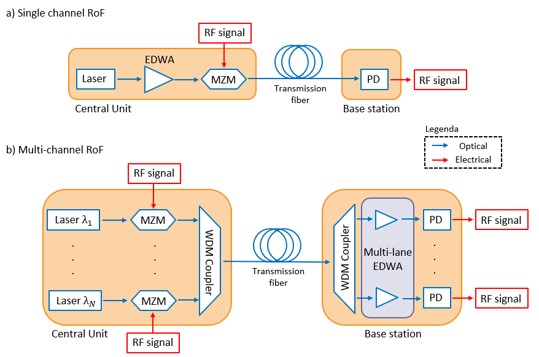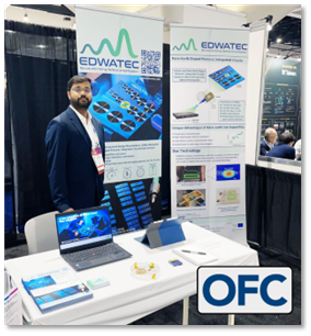Pillar I: AN200 Si3N4 Process Development for Ion-implantation ready Wafers (LGTF)
The first pillar of MAGNIFY entails establishing the AN200 Si3N4 process technology by LIGENTEC France in the 200 mm line of X-FAB, with world leading performance at an industrial level and prepare it for active integration such as ion-implantation.
To reach those objectives, wafers with 200 nm Si3N4 with bottom oxide with different thicknesses are being studied in terms of refractive index and thickness uniformity. Besides, a large range of top oxide thicknesses is proposed depending on the needs of the post-processing by EPFL, in particular the Erbium doping.
On the other hand, a process control monitoring testing cell is being developed to extract 200 nm SiN related metrics such as loss analysis and process control parameters.
The AN200 technology and documentation describing the process and design rules, as well as the different layers used is in progress.
Pillar II: Prototype Development
The second pillar of MAGNIFY aims to develop a prototype of a fully integrated multiple-lane erbium-doped waveguide amplifier (EDWA), and to ship the device to partners and early access demonstrator clients after comprehensive performance evaluation. This is to be realized by applying high-concentration erbium ion implantation to low loss silicon nitride photonic integrated circuits, which is based on a patented technology by EPFL in 2022. This technology development includes the device simulation, ion implantation recipe optimization, the preparation and submission of the wafer design layout, post wafer-scale processing, and systemic tests. The target devices are expected to simultaneously integrate key on-chip components such as WDM couplers, power splitters, and gain spiral waveguide, which can facilitate the miniaturization of the entire amplifier devices.
In Year 1, EPFL fabricated 200 nm thick Si3N4 wafers for proof-of-concept demonstration of a new Er-doped integrated photonic platform, optimized erbium doping fluences in the thin-nitride photonic wafers through several commercial vendors, measured passive loss, established a mature WDM coupler library that are consistent with simulations, successfully measured off-chip (fiber-to-fiber) net gain in samples up to 17 dB using a 1480 nm pump. EPFL performed in-house packaging in butterfly modules of selected erbium-doped chips and measured off-chip net gain of 15 dB in a packaged single-lane hybrid integrated EDWA. To investigate the potential of mass-production and the compatibility of the entire manufacturing processes with commercial industrial wafer foundries, EPFL has taped out the photonic circuit designs and submitted it to LIGENTEC France for 8-inch wafer fabrication, which will produce wafers ready for subsequent wafer-scale ion implantation and post processing.
Pillar III: Demonstration of Technology
The third pillar of MAGNIFY aims to demonstrate the full potential of the fully integrated multiple-lane erbium-doped waveguide amplifier (EDWA), particularly in the fields of coherent communications and microwave photonics. This involves different key activities, such as the design of proof-of-concept experiments and the detailed performance analysis to address the effectiveness of the EDWA technology in these fields. Through these activities, we aims to bridge the gap between lab prototypes and market-ready products, ensuring that the EDWA technology is robust, reliable, and ready for widespread adoption in the telecommunications industry.
A first EDWA demonstration will be carried out by SSSA regarding the radio-over-fiber (RoF) systems for radar applications and multi-channel RoF for RadCom phased-array antennas[1][2]. In particular, as shown in the upper right figure, the systems consist of a central unit (CU) that includes the laser sources and electro-optical modulators (E/O), the transmission fiber and a base station (BS) that houses the photodiodes (O/E). In the case of multi-channel links, wavelength division multiplexer (WDM) couplers are required on both the CU and BS, the latter with the addition of multi-lane EDWAs. Target key performance indicators (KPIs) include high RF bandwidth 1-40 GHz, low RF-to-RF loss, >4 antenna systems and extremely small size of approx. 7x5x1 cm^3.
The second EDWA demonstration will be carried out by KIT in high-speed communications and ultra-wideband photonic-electronic signal processing[3][4]. One of the proposed experiments, shown in the bottom right figure, relies on a hybrid-integrated optical arbitrary waveform measurement (OAWM) system. Here, we propose to integrate a demultiplexer (DEMUX) alongside EDWA on a common chip. By stabilizing the temperature of the whole assembly, along with proper synchronization of the comb’s free spectral range (FSR) with the back-end acquisition electronics, the phase offset between comb lines can be stabilized. This simplifies subsequent digital signal processing (DSP). Recently, we developed the OAWM engine, based on silicon photonics with optical coupling interfaces compatible with a 5-lane EDWA for this experiment.
Reference:
[1] Ghelfi, P., Laghezza, F., Scotti, F. et al. A fully photonics-based coherent radar system. Nature 507, 341–345 (2014). https://doi.org/10.1038/nature13078.
[2] Malacarne, S. Maresca, F. Scotti, P. Ghelfi, G. Serafino and A. Bogoni, “Coherent Dual-Band Radar-Over-Fiber Network With VCSEL-Based Signal Distribution,” in Journal of Lightwave Technology, vol. 38, no. 22, pp. 6257-6264, 15 Nov.15, 2020.
[3] P. Maier et al., “3D Freeform Millimeter-Wave and THz Structures Based on Multi-Photon Lithography,” in OFC, Mar. 2024, Paper W2A.5.
[4] D. Fang et al., “Spectrally Sliced Optical Arbitrary Waveform Measurement (OAWM) Using a Photonic Multi-Chip Receiver Assembly,” in OFC, Mar. 2024, Paper Tu2A.4.
Pillar IV: Early access demonstrator studies
The fourth pillar of the MAGNIFY focuses on early access demonstrator studies to engage industry partners and R&D labs with the cutting-edge Erbium-Doped Waveguide Amplifiers (EDWA) and the AN200 process developed by the consortium. This approach aims to foster collaboration, gather valuable feedback, and drive iterative improvements to ensure the technologies meet real-world demands and pave the way for successful commercialization.
During the first year of the project, significant strides have been made in presenting these technologies at major industry tradeshows and initiating discussions with potential early adopters. Key events included the SPIE Photonics West 2024 and the Optical Fiber Communication (OFC) conference, where the EDWA technology garnered attention for its potential applications in various high-demand sectors such as optical interconnects in data centers, long-haul optical communication, and satellite free-space communications.
Achievements in year 1 of the project:
- Trade Show Participation: EDWATEC actively participated in several major tradeshows, including Photonics West 2024 and OFC 2024, showcasing the EDWA technology to a broad audience. These events facilitated numerous discussions with potential customers, providing insights into market needs and application requirements.
- Feedback and Iteration: The interactions at these events underscored the high interest in compact, power-efficient optical amplifiers for data center interconnects, long-haul communication, and satellite communications. Feedback will be utilized to refine the EDWA designs, focusing on polarization handling, power consumption, and output power requirements.
- Collaborations: EDWATEC established preliminary communication channels with several companies in the optical communication sector, laying the groundwork for future collaboration and evaluation of the early access demonstrator devices.





